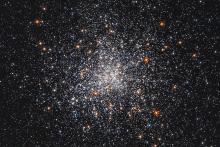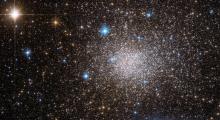Listen to today's episode of StarDate on the web the same day it airs in high-quality streaming audio without any extra ads or announcements. Choose a $8 one-month pass, or listen every day for a year for just $30.
You are here
Visiting a Cluster
Under dark skies, the human eye can see a few planets, a few thousand individual stars, and the combined glow of millions of stars in the band of light known as the Milky Way. Yet there is much more to the universe than the eye can perceive. Telescopes reveal many more wonders, from the remnants of dead stars to colliding galaxies.
One of those wonders is appearing quite near Jupiter right now. The solar system’s largest planet is about a third of the way up the southern sky at nightfall. It looks like a brilliant star — the brightest object in the sky for most of the night.
Quite close to the lower left of Jupiter, there’s a vast cluster of stars. But it’s so far away that you need a good-sized telescope to see it.
NGC 6235 is about 37,000 light-years from Earth. It’s a globular cluster. It contains hundreds of thousands of stars, all packed into a tight ball. The stars are all quite old. In fact, they’re probably some of the oldest stars in the galaxy.
NGC 6235 lines up more than 10,000 light-years beyond the center of the Milky Way Galaxy. It’s also a little above the galactic plane — the plane that divides the galaxy’s disk into northern and southern halves. If the cluster were closer to the plane, it would stand behind thick clouds of dust. That would make it really hard to see. Instead, it’s only pretty hard to see — a target for a good telescope on a dark night, not far from brilliant Jupiter.






